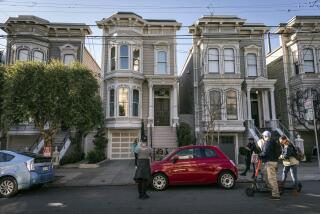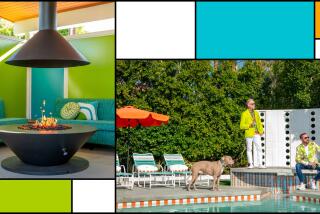When Haight Turned to Love
SAN FRANCISCO — Thirty years on, they still come. Pilgrims on a journey to the heartland of a dream. Young or old, it doesn’t matter. People of all ages and from every place on Earth keep arriving to gaze upon the edifices of an era, wondering about the magic that happened inside, feeling the spirit that lingers.
A romanticized version of the Summer of Love still rings true to a lot of people. On Sunday, an anniversary concert in Golden Gate Park will celebrate the celebration that was 1967, and as it approaches, awareness grows of the heritage that still exists here. Two Victorian buildings in and around the Haight-Ashbury district--the houses of the bands who formed the soundtrack of the times--have come close to being shrines.
Because Victorian structures are protected in San Francisco, their outward appearances do not change, so the Grateful Dead and Jefferson Airplane houses still provide some of the most visible and tangible focuses on the Summer of Love’s legacy.
*
Carve out any period during a weekend afternoon and you’ll find visitors radiating to the Dead house, a short walk up from Haight Street at 710 Ashbury. Last week, Cathy Geraghty of Dublin, Ireland, came for the first time to see what always has been so important to her.
“This used to be the center of everything,” said the 23-year-old. “This is where it started.” Even though she wasn’t born until years after the Haight’s heyday, the house resonates for her. She can feel “a certain energy” that the Dead “left behind. This whole area used to be a holy area,” she said, with a vague reference to Native Americans.
Actually, 710 Ashbury was built as a three-unit working-class apartment at the turn of the century, a very typical structure at the time with ornate Victorian trimmings and modest stained glass.
Later, it was carved into smaller units. By 1966, it was being run by Danny Rifkin, who also was the fledgling Dead’s co-manager. By the fall of that year, he’d convinced the members of the band to move in.
710 Ashbury also housed the Haight Ashbury Legal Organization (HALO), a volunteer group of lawyers helping out the hippies. HALO’s services were needed in October 1967 when most of the Dead were arrested in a drug bust. A photograph of guitarist Bob Weir and others being led away to jail became an icon of the resistance movement.
The Dead moved out in March ’68. Last weekend, as part of the 30th anniversary observance, the house went up for auction. A percentage of the proceeds was to have benefited local charities, including the Haight-Ashbury Free Clinic. But the minimum bid was $990,000 and there were no takers.
“It didn’t move, so we’re happy to stay there,” said Michael Felice, 60, whose family has lived in the house for 20 years. “It would have been like giving up a good friend.”
*
Two months after the Dead moved out of Ashbury Street, the Jefferson Airplane bought a majestic, four-story, Corinthian-columned mansion at 2400 Fulton St. on the edge of the Haight across from Golden Gate Park. The price: $65,000.
The house, built by a lumber baron at the beginning of the century, was at the other end of the spectrum from a hippie crash-pad, and the anti-establishment Airplane thought it was a hoot to traipse around inside. Playing at rich and famous suited the band’s sense of absurdity. But, of course, at this point the band was rich and famous, and its purchase of the mansion actually signaled that the counterculture had taken over as rock’s new royalty.
(Did the Airplane know that Enrico Caruso had stayed in this house, in sumptuous comfort, as a refugee from the 1906 earthquake after emerging from the wreckage of the Fairmont Hotel on Nob Hill?)
By the time the Airplane sold the house in 1985--for ten times more than the band paid for it--many extravagant parties had taken place there. The aftermath of a blowout in September ’68 was immortalized as the cover of an Airplane album, “Bless Its Pointed Little Head.”
Several blocks up the hill from Haight Street, the house never has drawn much in the way of casual strollers, but numerous near-accidents have been caused by the many cars that pull over with a sudden jerk as drivers realize they’re in the 2400 block and spot those famous white columns.
More to Read
Sign up for The Wild
We’ll help you find the best places to hike, bike and run, as well as the perfect silent spots for meditation and yoga.
You may occasionally receive promotional content from the Los Angeles Times.






